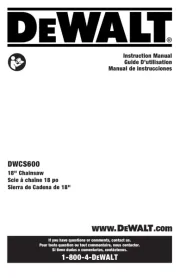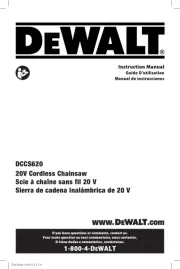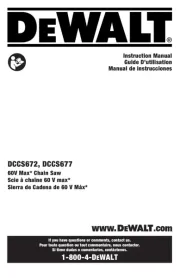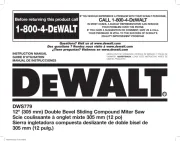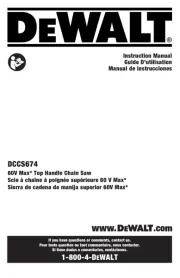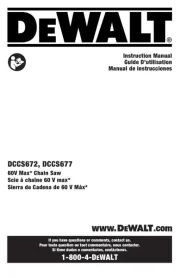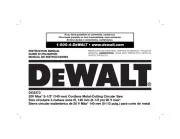INSTRUCTION MANUAL
GUIDE D'UTILISATION
MANUAL DE INSTRUCCIONES
DW307M, DW308M, DW309
VS Reciprocating Saws
Scies alternatives à régulateur de vitesse
Sierras reciprocantes VV
INSTRUCTIVO DE OPERACIÓN, CENTROS DE SERVICIO Y PÓLIZA
DE GARANTÍA. LÉASE ESTE INSTRUCTIVOADVERTENCIA:
ANTES DE USAR EL PRODUCTO.
IF YOU HAVE ANY QUESTIONS OR COMMENTS ABOUT THIS OR ANY DEWALT TOOL,
CALL US TOLL FREE AT 1-800-4-DEWALT (1-800-433-9258).
General Safety Instructions
WARNING! Read and understand all instructions. Failure to follow all instruc-
tions listed below, may result in electric shock, fire and/or serious personal injury.
SAVE THESE INSTRUCTIONS
WORK AREA
•Keep your work area clean and well lit. Cluttered benches and dark areas invite accidents.
•Do not operate power tools in explosive atmospheres, such as in the presence of flam-
mable liquids, gases, or dust. Power tools create sparks which may ignite the dust or fumes.
•Keep bystanders, children, and visitors away while operating a power tool. Distractions
can cause you to lose control.
ELECTRICAL SAFETY
•Grounded tools must be plugged into an outlet properly installed and grounded in
accordance with all codes and ordinances. Never remove the grounding prong or
modify the plug in any way. Do not use any adaptor plugs. Check with a qualified elec-
tician if you are in doubt as to whether the outlet is properly grounded. If the tools should elec-
trically malfunction or break down, grounding provides a low resistance path to carry elec-
tricity away from the user. Applicable only to Class I grounded tools.
•Double insulated tools are equipped with a polarized plug (one blade is wider than the
other.) This plug will fit in a polarized outlet only one way. If the plug does not fit fully
in the outlet, reverse the plug. If it still does not fit, contact a qualified electrician to
install a polarized outlet. Do not change the plug in any way. Double insulation elim-
inates the need for the three wire grounded power cord and grounded power supply system.
Applicable only to Class II (double insulated) tools.
•Avoid body contact with grounded surfaces such as pipes, radiators, ranges and
refrigerators. There is an increased risk of electric shock if your body is grounded.
•Don’t expose power tools to rain or wet conditions. Water entering a power tool will
increase the risk of electric shock.
•Do not abuse the cord. Never use the cord to carry the tools or pull the plug from an
outlet. Keep cord away from heat, oil, sharp edges or moving parts. Replace damaged cords
immediately. Damaged cords increase the risk of electric shock.
•When operating a power tool outside, use an outdoor extension cord marked “W-A”
or “W.” These cords are rated for outdoor use and reduce the risk of electric shock. These
cords are rated for outdoor use and reduce the risk of electric shock. When using an exten-
sion cord, be sure to use one heavy enough to carry the current your product will draw. An
undersized cord will cause a drop in line voltage resulting in loss of power and overheating.
The following table shows the correct size to use depending on cord length and nameplate
ampere rating. If in doubt, use the next heavier gage. The smaller the gage number, the
heavier the cord.
Minimum Gage for Cord Sets
Recommended Minimum Wire Size for Extension Cords
Total Length of Cord
25 ft. 50 ft. 75 ft. 100 ft. 125 ft. 150 ft. 175 ft.
7.6 m 15.2 m 22.9 m 30.5 m 38.1 m 45.7 m 53.3 m
Wire Size
18 AWG 18 AWG 16 AWG 16 AWG 14 AWG 14 AWG 12 AWG
PERSONAL SAFETY
•Stay alert, watch what you are doing and use common sense when operating a power
tool. Do not use tool while tired or under the influence of drugs, alcohol, or medication.
A moment of inattention while operating power tools may result in serious personal injury,
•Dress properly. Do not wear loose clothing or jewelry. Contain long hair. Keep your hair,
clothing, and gloves away from moving parts. Loose clothes, jewelry, or long hair can be
caught in moving parts. Air vents often cover moving parts and should also be avoided.
•Avoid accidental starting. Be sure switch is off before plugging in. Carrying tools with your
finger on the switch or plugging in tools that have the switch on invites accidents.
•Remove adjusting keys or wrenches before turning the tool on. A wrench or a key that
is left attached to a rotating part of the tool may result in personal injury.
•Do not overreach. Keep proper footing and balance at all times. Proper footing and balance
enables better control of the tool in unexpected situations.
•Use safety equipment. Always wear eye protection. Dust mask, non-skid safety shoes,
hard hat, or hearing protection must be used for appropriate conditions.
TOOL USE AND CARE
•Use clamps or other practical way to secure and support the workpiece to a stable
platform. Holding the work by hand or against your body is unstable and may lead to loss
of control.
•Do not force tool. Use the correct tool for your application. The correct tool will do the
job better and safer at the rate for which it is designed.
•Do not use tool if switch does not turn it on or off. Any tool that cannot be controlled with
the switch is dangerous and must be repaired.
•Disconnect the plug from the power source before making any adjustments,
changing accessories, or storing the tool. Such preventative safety measures reduce
the risk of starting the tool accidentally.
•Store idle tools out of reach of children and other untrained persons. Tools are dan-
gerous in the hands of untrained users.
•Maintain tools with care. Keep cutting tools sharp and clean. Properly maintained tools,
with sharp cutting edges are less likely to bind and are easier to control.
•Check for misalignment or binding of moving parts, breakage of parts, and any other
condition that may affect the tools operation. If damaged, have the tool serviced before
using. Many accidents are caused by poorly maintained tools.
•Use only accessories that are recommended by the manufacturer for your model.
Accessories that may be suitable for one tool, may become hazardous when used on
another tool.
SERVICE
•Tool service must be performed only by qualified repair personnel. Service or mainte-
nance performed by unqualified personnel could result in a risk of injury.
•When servicing a tool, use only identical replacement parts. Follow instructions in the
Maintenance section of this manual. Use of unauthorized parts or failure to follow
Maintenance Instructions may create a risk of electric shock or injury.
Additional Specific Safety Rules
•Hold tool by insulated gripping surfaces when performing an operation where the cut-
ting tool may contact hidden wiring or its own cord. Contact with a “live” wire will make
exposed metal parts of the tool “live” and shock the operator.
• Do not operate this tool for long periods of time. Vibration caused by the operating action
of this tool may cause permanent injury to fingers, hands, and arms. Use gloves to provide
extra cushion, take frequent rest periods, and limit daily time of use.
CAUTION: Wear appropriate personal hearing protection during use. Under some con-
ditions and duration of use, noise from this product may contribute to hearing loss.
WARNING: Some dust created by power sanding, sawing, grinding, drilling, and other con-
struction activities contains chemicals known to cause cancer, birth defects or other reproductive
harm. Some examples of these chemicals are:
• lead from lead-based paints,
• crystalline silica from bricks and cement and other masonry products, and
• arsenic and chromium from chemically-treated lumber (CCA).
Your risk from these exposures varies, depending on how often you do this type of work. To
reduce your exposure to these chemicals: work in a well ventilated area, and work with approved
safety equipment, such as those dust masks that are specially designed to filter out microscopic
particles.
•Avoid prolonged contact with dust from power sanding, sawing, grinding, drilling,
and other construction activities. Wear protective clothing and wash exposed areas
with soap and water. Allowing dust to get into your mouth, eyes, or lay on the skin may pro-
mote absorption of harmful chemicals.
WARNING: Use of this tool can generate and/or disburse dust, which may cause serious and
permanent respiratory or other injury. Always use NIOSH/OSHA approved respiratory protection
appropriate for the dust exposure. Direct particles away from face and body.
• The label on your tool may include the following symbols.
V..........volts A ..........amperes
Hz........hertz W ..........watts
min ......minutes ........alternating current
....direct current n o ........no load speed
..........Class II Construction …/min ..revolutions or reciprocation per minute
........earthing terminal ........safety alert symbol
Trigger Switch (Fig. 1)
The variable speed trigger switch (A) will give you added versatility. The further the trigger is
depressed the higher the speed of the saw. To turn the tool “OFF” release the trigger.
CAUTION: Use of very slow speed is recommended only for beginning a cut. Prolonged
use at very slow speed may damage your saw.
Speed Range Selector Wheel (DW309) (Fig. 2)
A variable speed selector wheel has been provided to control the speed of the tool. To select a
slow speed for operating your saw, rotate the wheel to a low number on the dial. To select a
higher speed, rotate the wheel to a higher number.
Adjustable Shoe (Fig. 3)
CAUTION: TURN OFF AND UNPLUG SAW.
The shoe will adjust to limit the depth of cut. Hold the saw with the underside facing up. Push
the button on the hand grip and slide the shoe out to one of the three settings and release the
button.
Blade Clamp Release Lever (Fig. 4)
CAUTION: TURN OFF AND UNPLUG SAW.
To install blade into saw:
1. Open blade clamp release lever up.
2. Insert blade shank from the front.
3. Close blade clamp release lever down.
To remove blade from saw:
1. Open up blade clamp release lever.
2. Remove blade.
Operation
CAUTION: Always wear eye protection while operating this or any other power tool.
Flush-To Cutting (Fig. 5)
The compact design of the saw motor housing and spindle housing permits extremely close cut-
ting to floors, corners and other difficult areas.
CAUTION: When sawing into walls, floors or wherever “live” electrical wires may be encoun-
tered, DO NOT TOUCH ANY FRONT METAL PARTS OF THE TOOL! Hold the tool only by the
plastic or rubber handle and housing to prevent electric shock if you saw into a “live” wire.
Wood Cutting (Fig. 6)
Before cutting any type of wood, be sure it is firmly anchored or clamped to prevent slipping.
Place blade lightly against work to be cut, switch on saw motor and allow it to obtain maximum
speed before applying pressure. Always hold saw firmly with both hands while cutting.
Whenever possible, the saw shoe must be held firmly against the material being cut. This will
prevent the saw from jumping or vibrating and minimize blade breakage.
Metal Cutting (Fig. 7)
This unit has different metal cutting capacities depending upon type of blade used and the metal
to be cut. Use a finer blade for ferrous metals and a coarse blade for non-ferrous materials. In
thin gauge sheet metals it is best to clamp wood to both sides of sheet. This will insure a clean
cut without excess vibration or tearing of metal. Always remember not to force cutting blade as
this reduces blade life and causes costly blade breakage. To prolong blade life, use other areas
of the blade by adjusting the shoe position (See Adjustable Shoe).
DEWALT Industrial Tool Co., 701 East Joppa Road, Baltimore, MD 21286
(AUG04-CD-1) Form No. 627149-00 DW307M, 308M, 309 Copyright © 2000, 2003, 2004 DEWALT
The following are trademarks for one or more DEWALT power tools: the yellow and black color scheme; the
“D” shaped air intake grill; the array of pyramids on the handgrip; the kit box configuration; and the array of
lozenge-shaped humps on the surface of the tool.
Questions? See us in the World Wide Web at www.dewalt.com
